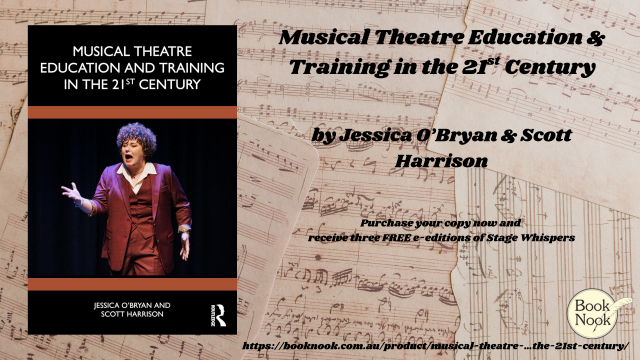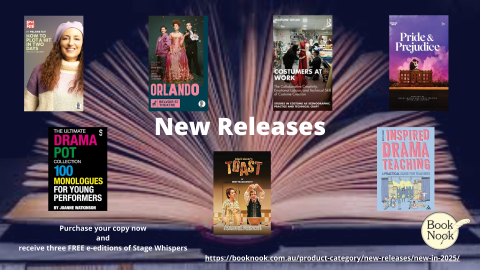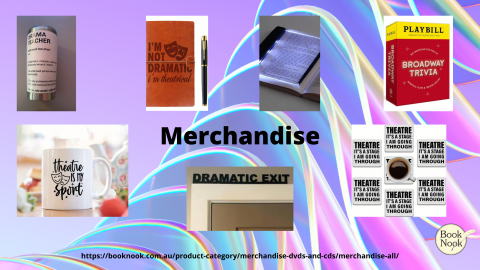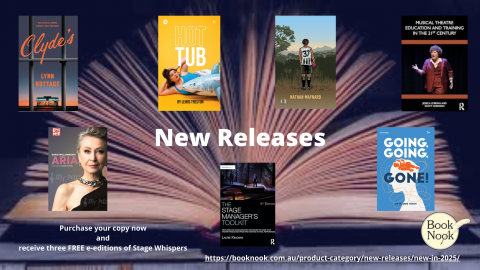Musical Theatre Education and Training in the 21st Century

By Jessica O’Bryan and Scott Harrison (Routledge)
Reviewed by Peter Pinne.
Click here to purchase your copy at Book Nook
Broadway composer Maury Yeston believes this book will “have a profound effect on the learning curve of theatre programs all over the world,” a sentiment I heartily endorse. In a niche market where there is very little, if any, published documentation, it’s a welcome relief. The authors have interviewed 100 off and on-stage personnel from Australia, Canada, Broadway and West End, and produced a unique document which fills a much-needed void.
Writer Jessica O’Byran, a former opera singer, jazz and pop artist, lectures and tutors in music and education in several universities across Southeast Queensland, whilst her writing partner Scott Harrison, also a former opera singer, is Pro Vice Chancellor of Arts Education and Law and Assistant Chancellor of Cultural Curation and Community Partnership at Griffith University Australia. They both acknowledge the book was the idea of Paul Sabey, a former Director of the Musical Theatre programme and Associate Principal at Mountview Academy of Theatre Arts in the UK, prior to his appointment as Head of Musical Theatre at Queensland Conservatorium Griffith University for 12 years.
It took five years to research and write.
Times have changed and the curriculum that is taught nowadays is far different to that taught in Broadway’s hey-day.
“Musical theatre performers today are vocal and physical athletes. Everybody sings, dances and acts. The sheer punishment of Elphaba’s ‘No Good Deed’ from Wicked, which requires racing around the stage and up through a trap, screaming and ranting while metamorphosing into evil incarnate, is a huge physical and emotional challenge for a young singer regardless of talent and skill. To do this eight times a week seems almost impossible.” (LoVetri). Stephen Schwartz’s admiration for Idina Menzel, who created the part, elucidates further. “She worked with a vocal coach basically for a year to be able to sing the score of Wicked eight times a week.
There is now greater recognition amongst producers that some roles require too much of the human voice, and in recent years we are seeing more examples of a job-share arrangement. The Phantom of the Opera has done this throughout its entire run, whereby the alternate Christine will sing two performances a week, giving the star a rest to save the voice.
In training the voice, John Caird (RSC) thinks “there should be more classes in the art of listening. People tend to copy a lot. The kids go into musical theatre because they’re in love with it, they’ve heard musicals, they fall in love with musicals, they’re musical fans. And they want to copy and sound like other people who have sung things. But they’re not actually listening to the music that they’re singing. They’re in love with a way in which the music is being performed.”
The literature on the teaching of singing is perhaps the most extensive of all, but less about the teaching of musical theatre specifically. Current composers push the boundaries of the voice whilst respecting the traditions of the past, an example being how close some of the Hamilton rap is to Gilbert and Sullivan, and the coloratura work required of Glinda in the opening bars of Wicked, alongside the belt and mix required later in the piece.
Of course, as with singing in musical theatre, the principal foundation of the actors’ craft is storytelling. Story is always key according to UK Producer Paul Taylor-Mills. He quotes Andrew Lloyd Webber - “You can have brilliant songs and an okay story, and it’s a bit sniffy. But if you’ve got a brilliant story and mediocre songs, you’re fine.”
There’s been a long-held belief that singers are not actors. Stephen Schwartz gave a pertinent example in which modern performers have adapted. Going back to the forties he cites “Alfred Drake and John Raitt as solid singers but not particularly good actors. Compare that to with Ben Platt from Dear Evan Hanson, just a recent example, that’s light years’ difference in terms of acting ability.”
Trevor Jones (Musical Director) said, “I think text analysis is probably the most important thing in an actor’s training,” with Paul Taylor-Mills suggesting that “for Hamilton a strong training in verse is imperative.”
Lin-Manuel Miranda said that “when they’re casting Hamilton, most of the people they actually see (who they) prefer to play Hamilton have had Royal Shakespeare Company training because they can speak in verse.”
David Shirley (WAAPA) says, “I’ve always kind of deferred to the Stanislavsky principle, sometimes influenced by Uta Hagen, but not overly heavily influenced by The Method, because I think that serves a slightly different purpose. But something in which they (young actors) recreate segments of their own lives in a natural way, without performing, so that they understand the notion of theatre as artifice, as art form, that is artificial, but they know how to invest that with truthfulness.”
The notion of ensembles that sing and dance is a relatively recent phenomenon. Alan Jay Lerner notes it was Oklahoma! in 1943 where there was a total amalgamation of the theatrical arts, although the parts of Laurey and Curley were danced by ballet dancers in the dream ballet. West Side Story took that further in 1957, but still had ballet dancers in the ‘Somewhere’ ballet. It wasn’t until A Chorus Line (1975), and the works of Lin-Manuel Miranda - In the Heights (2008) / Hamilton (2015) - that dance become fully integrated.
There is a cultural bias in Western countries that relegates the performing arts, and dance in particular, to activities that are too ‘girly’ or sissy for boys to do.
Chris Horsey (Choreographer), whose mother ran a dance school, was constantly prone to bullying and name calling. “It wasn’t an easy time. I have two older brothers who danced as well and they copped it, so I don’t think I copped it as bad as them.”
Julio Agustin (US Artist) said of his experience as an artist, “that dancing, whilst perhaps the hardest route to take, was also the best as there were fewer great dancers than singers. And I got to work with Chita Rivera and Gwen Verdon, as well as some great choreographers.”
There’s a chapter on being a good company member and getting on well with others. Paul Sabey calls it the fourth skill after singing, dancing and acting.
Rob Archibald (Urdang) says, “It’s about the job, we make sure they’ve got the discipline. Rehearsal etiquette, rehearsal room etiquette, audition room etiquette. When you move into [the profession], how do you deal with doing the same thing eight times a week for a year?
Lyricist Lynne Ahrens notes that actors “Need to respect their fellow performers onstage and off.
Since Courtney Monsma became a Disney princess she has never been out of a job.
Musical Theatre is an elitist profession. It will cost $230 per week for singing, acting and dance lessons, and at the end of it you may never get a role on stage. That’s why there have to be options. Some of them are ‘side hustles.’ Frequently performers develop a cabaret act - something they can pull out of their hat when the work dries up. Others write or produce. But you have to have something because you are going to be out of work a lot.
The book comes with biographies of all the interviewees, a listing of training institutions around the world, and an index.





